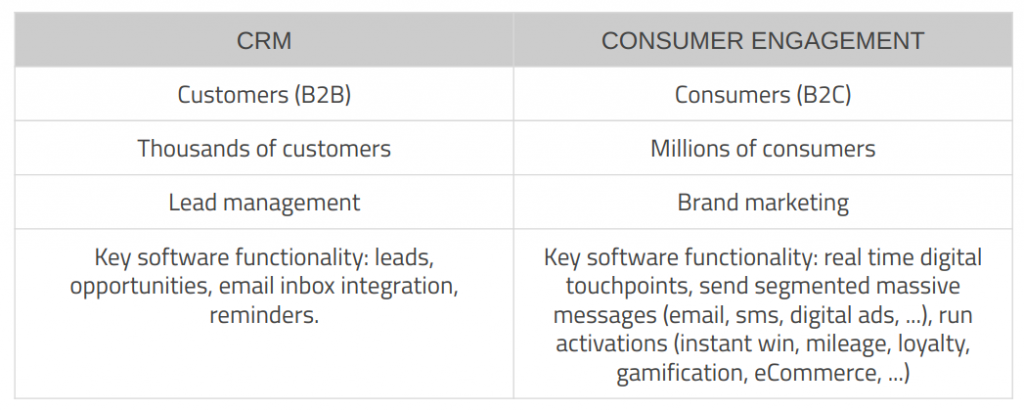Contact us to discuss this post or learn more about Thalamus
Industries that sell products to consumer markets don’t need a CRM solution; they need a Consumer Engagement one. This distinction is extremely important in order to avoid failing to achieve their business goals, after having paid for a CRM that nobody in the marketing organization uses.
What is CRM?
Customer Relationship Management focuses on lead management processes where there is a sales force whose work consists of generating leads, nurturing them and trying to convert them into customers. CRM is a great fit for B2B, companies that sell to other companies. Salesmen will send emails or call key contacts, organize meetings, and try to close a contract. And CRM software is great for helping with that.
Why Consumer Goods brands don´t do CRM
In companies that sell consumer goods (food, cars, cellphones, beverages, beauty products, etc.) marketing teams focus on developing your brand, its values, its image, running activities and promotions, managing advertising and sending outbound communications, ideally to millions of consumers.
Applying CRM to consumers would be ridiculous: imagine receiving a call at 10:00 AM from a Coca Cola salesman saying: “Hi Gaston, how do you do? Would you be interested in setting up a web conference to talk about Coca Cola’s benefits and how you can buy it from a store next to you?”
The solution? Consumer engagement
Consumer Engagement is about brand marketing: generating a long term relationship between consumers and the brand. Brands achieve this by communicating brand values that improve the bond and consumer identification with the brand, proposing experiences, or running activities and promotions that may help push product sales and loyalty.
A consumer engagement tool allows brands to:
- Build a unique consumer profile in a centralized database. All brand touchpoints (web, mobile, ambassadors, physical stores, call centers, etc.) will be connected to the consumer engagement software.
- Send segmented outbound communications to consumers based on their profile and behavior.
- Run connected and consistent brand marketing activities and promotions, such as Instant Wins, Raffles, Accumulation, Gamification, Surveys, etc.
- Automate the brand plan using all the tools previously mentioned, creating consumer journeys that handle millions of consumers.
- Provide a data warehouse and a business intelligence tool to be able to analyze results.
Key differences between CRM and Consumer Engagement
Let’s sum up the key differences between CRM and Consumer Engagement:

Conclusion
Failed CRM strategies and CRM software implementations in Consumer Goods come from this very issue: you are trying to use a CRM tool to do Consumer Engagement because they seem the same, but in fact they are not. It’s like trying to use a truck to run a Formula 1 race: it is a vehicle, but not the type you need.
For Consumer Goods brands, choose a Consumer Engagement solution.

